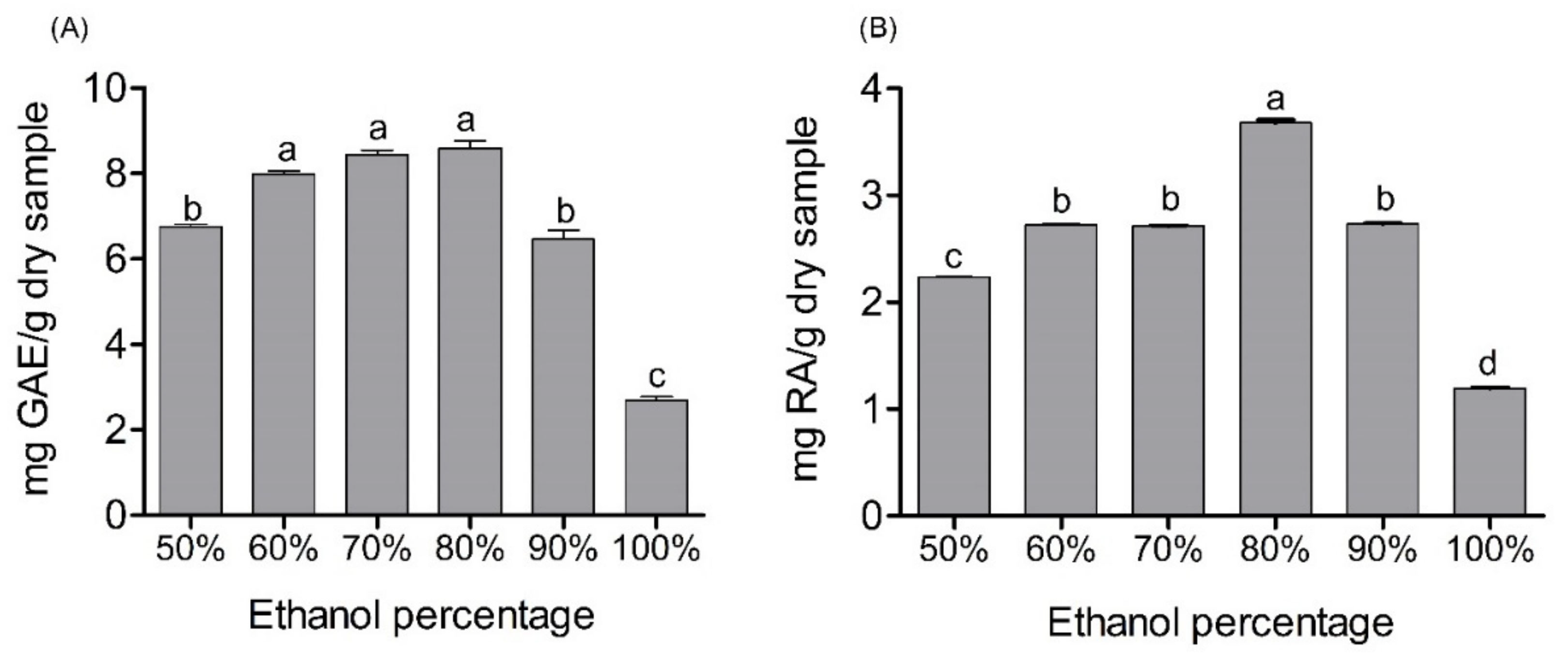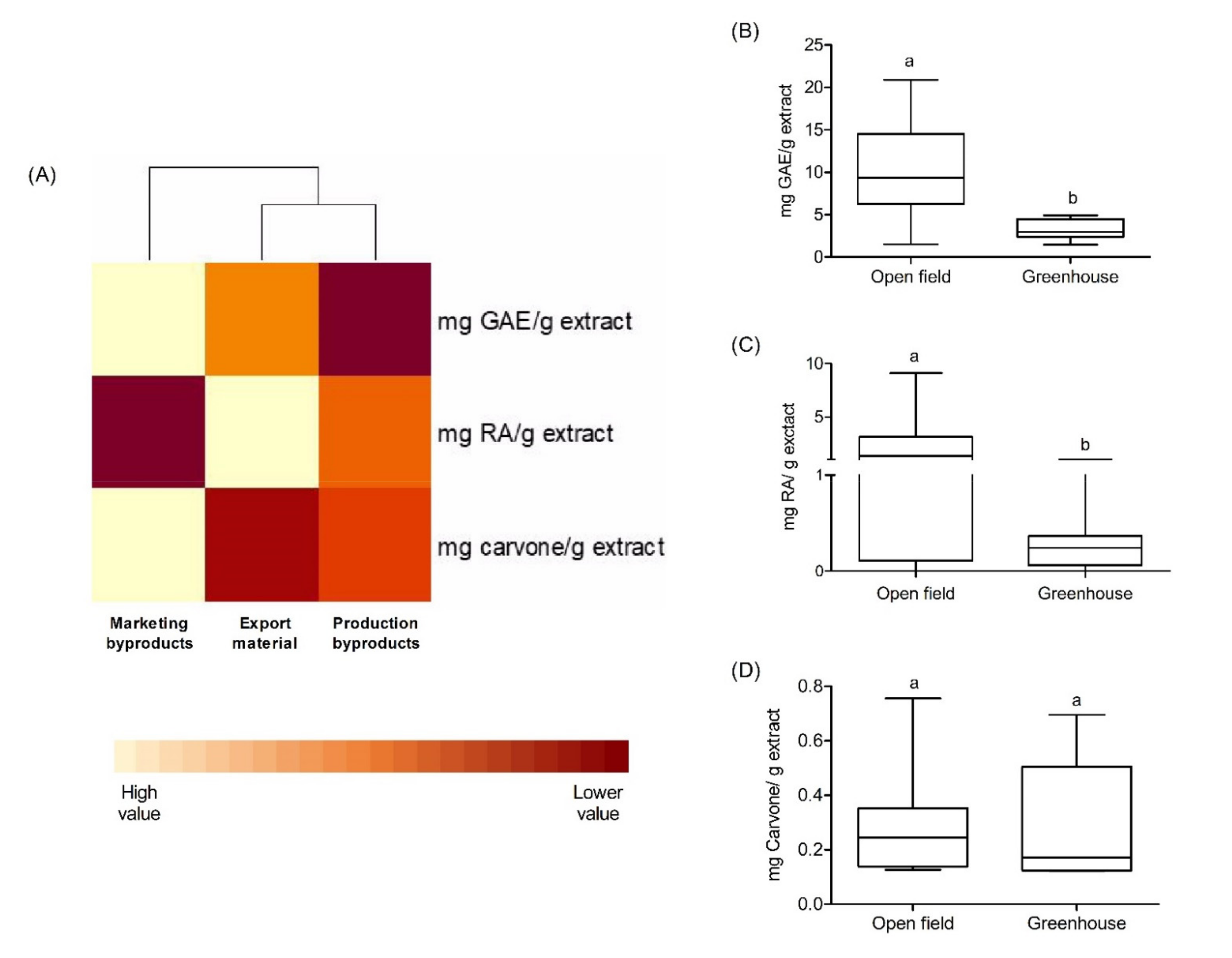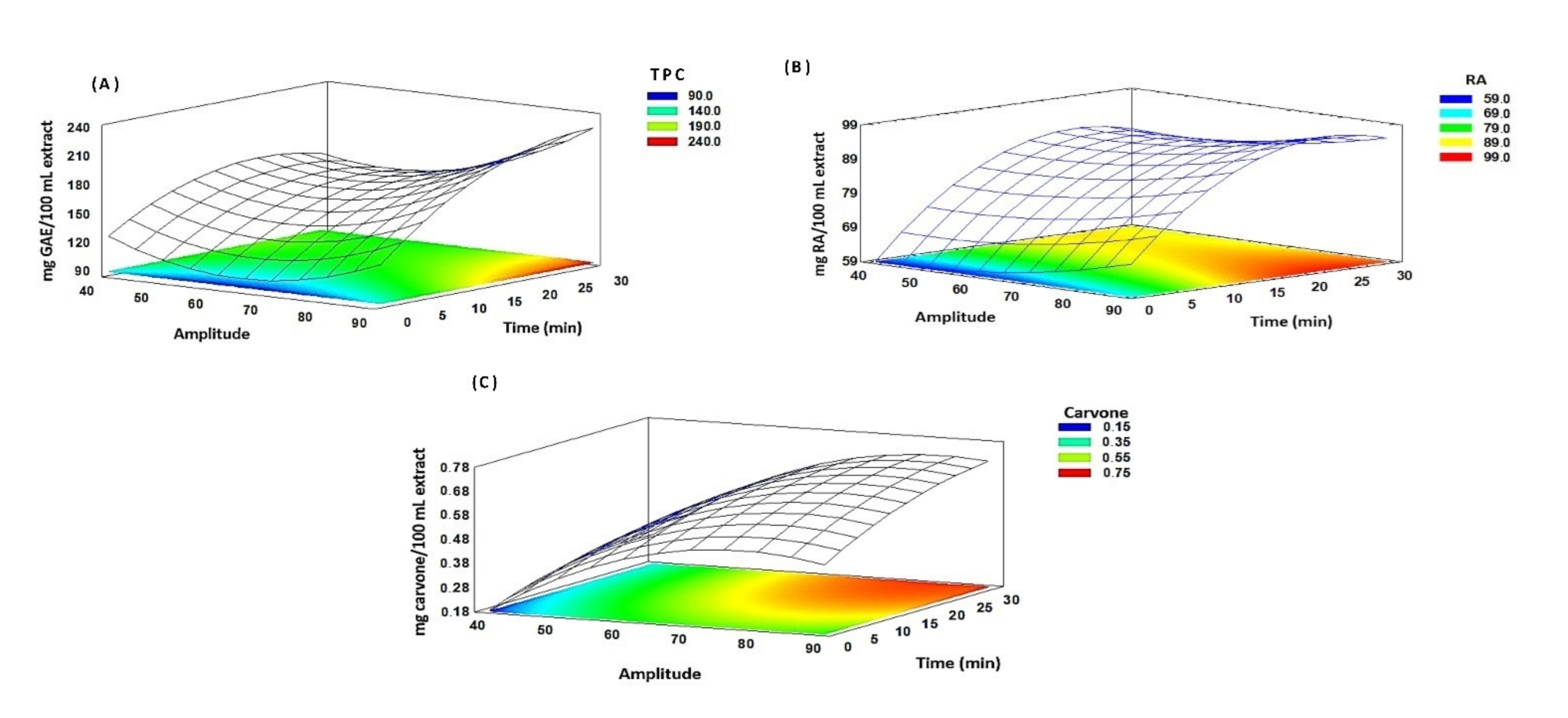Spearmint (Mentha spicata L.) Phytochemical Profile: Impact of Pre/Post-Harvest Processing and Extractive Recovery
Abstract
:1. Introduction
2. Results
2.1. Selection of Extraction Solvent
2.2. Determination of Total Phenolic Content on Byproducts and Export Material
2.3. Phenolic Compound Identification by HPLC-DAD on Byproducts and Export Material
2.4. HPLC-DAD-ESI/MSn Analysis on Marketing Byproducts
2.5. Gas Chromatography/Mass Spectrometry (GC/MS) Analysis on Byproducts and Export Material
2.6. Kinetics of Solid–Liquid Extraction by High-Intensity Ultrasound on Marketing Byproducts
3. Discussion
4. Materials and Methods
4.1. Chemicals
4.2. Plant Extracts
4.3. Preparation of Extractions
4.4. Determination of Total Phenolic Content (TPC)
4.5. Phenolic Compound Identification by HPLC-DAD
4.6. HPLC-DAD-ESI/MSn Analysis
4.7. Gas Chromatography/Mass Spectrometry (GC/MS) Analysis
4.8. Kinetics of Solid–Liquid Extraction by High-Intensity Ultrasound
5. Conclusions
Supplementary Materials
Author Contributions
Funding
Institutional Review Board Statement
Informed Consent Statement
Data Availability Statement
Acknowledgments
Conflicts of Interest
Sample Availability
References
- Cury, R.K.; Aguas, M.Y.; Martinez, M.A.; Olivero, V.R.; Chams Ch, L. Residuos Agroindustriales su Impacto, Manejo y Aprovechamiento. Rev. Colomb. Cienc. Anim.—RECIA 2017, 9, 122. [Google Scholar] [CrossRef] [Green Version]
- Peñaranda, L.V.; Montenegro, S.P.; Giraldo, P.A. Aprovechamiento de Residuos Agroindustriales en Colombia. Rev. Investig. Agrar. Ambiental. 2017, 8, 141–150. [Google Scholar] [CrossRef] [Green Version]
- Bonilla, C.R.; Guerrero, C.R. Menta (Mentha spp.). Producción y Manejo Poscosecha. Corporación Colombiana de Investigación Agropecuaria: Bogota, Colombia, 2010; pp. 1–102. [Google Scholar]
- Villegas, L.I. Componentes Para el Manejo Integrado de Plagas de Mentha spicata en Cultivos del Oriente Antioqueño. Master's Thesis, Universidad Nacional de Colombia, Medellín, Colombia, 2016. [Google Scholar]
- Prakash, O.; Chandra, M.; Pant, A.K.; Rawat, D.S. Mint (Mentha spicata L.) oils. In Essential Oils in Food Preservation, Flavor and Safety; Elsevier Inc.: Amsterdam, The Netherlands, 2016; pp. 561–572. [Google Scholar] [CrossRef]
- Vining, K.J.; Hummer, K.E.; Bassil, N.V.; Lange, B.M.; Khoury, C.K.; Carver, D. Crop wild relatives as germplasm resource for cultivar improvement in Mint (Mentha L.). Front. Plant Sci. 2020, 11, 1217. [Google Scholar] [CrossRef]
- Mansoori, S.; Bahmanyar, H.; Jafari-Ozumchelouei, E.; Najafipour, I. Investigation and optimisation of the extraction of carvone and limonene from the Iranian Mentha spicata through the ultrasound-assisted extraction method. Indian Chem. Eng. 2020. [Google Scholar] [CrossRef]
- Narasimhamoorthy, B.; Zhao, L.Q.; Liu, X.; Yang, W.; Greaves, J.A. Differences in the chemotype of two native spearmint clonal lines selected for rosmarinic acid accumulation in comparison to commercially grown native spearmint. Ind. Crops Prod. 2015, 63, 87–91. [Google Scholar] [CrossRef]
- Heng, M.Y.; Tan, S.N.; Yong, J.W.H.; Ong, E.S. Emerging green technologies for the chemical standardization of botanicals and herbal preparations. TrAC—Trends Anal. Chem. 2013, 50, 1–10. [Google Scholar] [CrossRef]
- Vilkhu, K.; Mawson, R.; Simons, L.; Bates, D. Applications and opportunities for ultrasound assisted extraction in the food industry—A review. Innov. Food Sci. Emerg. Technol. 2008, 9, 161–169. [Google Scholar] [CrossRef]
- Gavahian, M.; Farahnaky, A.; Farhoosh, R.; Javidnia, K.; Shahidi, F. Extraction of essential oils from Mentha piperita using advanced techniques: Microwave versus ohmic assisted hydrodistillation. Food Bioprod. Process. 2015, 94, 50–58. [Google Scholar] [CrossRef]
- Belwal, T.; Ezzat, S.M.; Rastrelli, L.; Bhatt, I.D.; Daglia, M.; Baldi, A.; Prasad Devkota, H.; Erdogan Orhan, I.; Kumar Patra, J.; Das, G.; et al. A critical analysis of extraction techniques used for botanicals: Trends, priorities, industrial uses and optimization strategies. TrAC—Trends Anal. Chem. 2018, 100, 82–102. [Google Scholar] [CrossRef]
- Chang, C.K.; Ko, W.C.; Chen, Y.A.; Chan, Y.J.; Cheng, K.C.; Lai, P.S.; Hsieh, C.W. Evaluation of using high-pressure homogenization technology in enhancing the aroma synthesis of sorghum spirits. Food Sci. Tecnol. 2018, 105, 314–320. [Google Scholar] [CrossRef]
- Chemat, F.; Zill-E-Huma; Kamran Khan, M. Applications of ultrasound in food technology: Processing, preservation and extraction. Ultrason. Sonochem. 2011, 18, 813–835. [Google Scholar] [CrossRef]
- Toma, M.; Vinatoru, M.; Paniwnyk, L.; Mason, T.J. Investigation of the effects of ultrasound on vegetal tissues during solvent extraction. Ultrason. Sonochem. 2001, 8, 137–142. [Google Scholar] [CrossRef]
- Chakraborty, S.; Uppaluri, R.; Das, C. Optimization of ultrasound-assisted extraction (UAE) process for the recovery of bioactive compounds from bitter gourd using response surface methodology (RSM). Food Bioprod. Process. 2020, 120, 114–122. [Google Scholar] [CrossRef]
- Li, Z.; Smith, K.H.; Stevens, G.W. The use of environmentally sustainable bio-derived solvents in solvent extraction applications—A review. Chin. J. Chem. Eng. 2016, 24, 215–220. [Google Scholar] [CrossRef]
- Sandilya, D.K.; Kannan, A. Effect of ultrasound on the solubility limit of a sparingly soluble solid. Ultrason. Sonochem. 2010, 17, 427–434. [Google Scholar] [CrossRef]
- Sumarni, N.K.; Hasanuddi, A.; Nuryanti, S.; Hutumo, G.S. Isolation and characterization of terpenoid compounds ethanol extract on young coconut coir (Cocos Nucifera L.). Int. J. Sci. Technol. Res. 2020, 9, 5622–5625. [Google Scholar]
- Bartnich, D.D.; Mohler, C.M.; Houlihan, M. Methods for the Production of Food Grade Extracts. U.S. Patent Application No. US20060088627A1, 4 May 2006. [Google Scholar]
- Rodríguez-Rojo, S.; Visentin, A.; Maestri, D.; Cocero, M.J. Assisted extraction of rosemary antioxidants with green solvents. J. Food Eng. 2012, 109, 98–103. [Google Scholar] [CrossRef] [Green Version]
- Dorman, H.J.D.; Koşar, M.; Kahlos, K.; Holm, Y.; Hiltunen, R. Antioxidant properties and composition of aqueous extracts from Mentha species, hybrids, varieties, and cultivars. J. Agric. Food Chem. 2003, 51, 4563–4569. [Google Scholar] [CrossRef]
- Kanatt, S.R.; Chander, R.; Sharma, A. Antioxidant potential of mint (Mentha spicata L.) in radiation-processed lamb meat. Food Chem. 2007, 100, 451–458. [Google Scholar] [CrossRef]
- Leguizamón-M, G.D.V.; González-León, A.; Sotelo-Mundo, R.R.; Islas-Osuna, M.A.; Bringas-Taddei, E.; García-Robles, J.M.; Islas-Osuna, M.; Sañudo, R.B.; Sotelo-Mundo, R.R.; Carvallo, T. Efecto del sombreado de racimos sobre color y calidad en uvas rojas para mesa (Vitis vinifera L.). Rev. Fitotec. Mex. 2008, 31, 7–17. [Google Scholar] [CrossRef]
- Salazar-García, S.; Medina-Carrillo, R.E.; Álvarez-Bravo, A. Influencia del riego y radiación solar sobre el contenido de fitoquímicos en la piel de frutos de aguacate ‘Hass’. Rev. Mex. Cienc. Agrícolas. 2017, 7, 2565. [Google Scholar] [CrossRef] [Green Version]
- Cheynier, V.; Comte, G.; Davies, K.M.; Lattanzio, V.; Martens, S. Plant phenolics: Recent advances on their biosynthesis, genetics, andecophysiology. Plant Physiol. Biochem. 2013, 72, 1–20. [Google Scholar] [CrossRef]
- Tuladhar, P.; Sasidharan, S.; Saudagar, P. 17—Role of phenols and polyphenols in plant defense response to biotic and abiotic stresses. In Biocontrol Agents and Secondary Metabolites; Jogaiah, S., Ed.; Woodhead Publishing: Cambridge, UK, 2021; pp. 419–441. [Google Scholar] [CrossRef]
- Mahendran, G.; Verma, S.K.; Rahman, L.U. The traditional uses, phytochemistry and pharmacology of spearmint (Mentha spicata L.): A review. J. Ethnopharmacol. 2021, 278, 114266. [Google Scholar] [CrossRef]
- Marchev, A.S.; Vasileva, L.V.; Amirova, K.M.; Savova, M.S.; Koycheva, I.K.; Balcheva-Sivenova, Z.P.; Vasileva, S.M.; Georgiev, M.I. Rosmarinic acid—From bench to valuable applications in food industry. Trends Food Sci. Technol. 2021, 117, 182–193. [Google Scholar] [CrossRef]
- Petersen, M.; Abdullah, Y.; Benner, J.; Eberle, D.; Gehlen, K.; Hücherig, S.; Janiak, V.; Kim, K.H.; Sander, M.; Weitzel, C.; et al. Evolution of rosmarinic acid biosynthesis. Phytochemistry 2009, 70, 1663–1679. [Google Scholar] [CrossRef]
- Petersen, M. Rosmarinic acid: New aspects. Phytochem. Rev. 2013, 12, 207–227. [Google Scholar] [CrossRef]
- Fabre, N.; Rustan, I.; Hoffmann, E.; de Quetin-Leclercq, J. Determination of flavone, flavonol, and flavanone aglycones by negative ion liquid chromatography electrospray ion trap mass spectrometry. J. Am. Soc. Mass Spectrom. 2001, 12, 707–715. [Google Scholar] [CrossRef] [Green Version]
- Brown, N.; John, J.A.; Shahidi, F. Polyphenol composition and antioxidant potential of mint leaves. Food Prod. Process. Nutr. 2019, 1, 1–14. [Google Scholar] [CrossRef] [Green Version]
- Cirlini, M.; Mena, P.; Tassotti, M.; Herrlinger, K.A.; Nieman, K.M.; Dall’Asta, C.; Del Rio, D. Phenolic and volatile composition of a dry spearmint (Mentha spicata L.) extract. Molecules 2016, 21, 1007. [Google Scholar] [CrossRef] [Green Version]
- Özer, Z. Investigation of phenolic compounds and antioxidant activity of Mentha spicata subsp. Spicata and M. longifolia subsp. typhoides (briq.) Harley decoction and infusion. J. Turkish Chem. Soc. Sect. A Chem. 2018, 5, 445–456. [Google Scholar] [CrossRef] [Green Version]
- Bucić-Kojić, A.; Planinić, M.; Tomas, S.; Bilić, M.; Velić, D. Study of solid-liquid extraction kinetics of total polyphenols from grape seeds. J. Food Eng. 2007, 81, 236–242. [Google Scholar] [CrossRef]
- Carrillo-Hormaza, L.; Duque, L.; López-Parra, S.; Osorio, E. High-intensity ultrasound-assisted extraction of Garcinia madruno biflavonoids: Mechanism, kinetics, and productivity. Biochem. Eng. J. 2020, 161, 107676. [Google Scholar] [CrossRef]
- Jokic, S.; Velic, D.; Bilic, M.; Bucic-Kojic, A.; Planinic, M.; Tomasa, S. Modelling of the process of solid-liquid extraction of total polyphenols from soybeans. Czech J. Food Sci. 2010, 28, 206–212. [Google Scholar] [CrossRef] [Green Version]
- Khandare, R.D.; Tomke, P.D.; Rathod, V.K. Kinetic modeling and process intensification of ultrasound-assisted extraction of d-limonene using citrus industry waste. Chem. Eng. Process.-Process Intensif. 2021, 159, 108181. [Google Scholar] [CrossRef]
- Jiménez, N.; Carrillo-Hormaza, L.; Pujol, A.; Álzate, F.; Osorio, E.; Lara-Guzman, O. Antioxidant capacity and phenolic content of commonly used anti-inflammatory medicinal plants in Colombia. Ind. Crops Prod. 2015, 70, 272–279. [Google Scholar] [CrossRef]
- Carvajal, D.; Alvarez, R.; Osorio, E. Chemical variability of essential oils of Protium colombianum from two tropical life zones and their in vitro activity against isolates of Fusarium. J. Pest. Sci. 2016, 89, 241–248. [Google Scholar] [CrossRef]




| Extraction Solvents % Relative | |||||||
|---|---|---|---|---|---|---|---|
| Compound | Essential Oil | Hexane: Ethyl Acetate 50:50 | Hexane: Ethyl Acetate 75:25 | 100% Hexane | 100% Ethyl Acetate | 100% Dichloromethane | 80% Ethanol |
| D-Limonene | 4.28 | 0.23 | |||||
| Neodihydrocarveol | 0.61 | ||||||
| Trans-Carveol | 4.00 | 3.72 | 2.82 | 9.11 | 6.09 | ||
| Carvone | 58.52 | 17.89 | 12.64 | 39.42 | 26.36 | 25.85 | 30.51 |
| Dihydrocarvyl acetate | 0.57 | ||||||
| Trans-Carveyl acetate | 0.75 | ||||||
| γ-Elemene | 0.67 | ||||||
| β-bourbenene | 3.59 | 0.79 | 3.11 | ||||
| β-Elemene | 1.75 | 0.47 | |||||
| β-Caryophyllene | 4.55 | 8.96 | |||||
| β-Copaen-4α-ol | 1.17 | 3.06 | |||||
| ε-Muurolene | 2.54 | ||||||
| (-)-Isogermacrene D | 0.84 | 4.10 | 2.39 | ||||
| (E)-β-Famesene | 0.93 | 1.5 | |||||
| cis-Muurola-4(15),5-diene | 1.07 | 1.60 | 0.80 | 5.72 | |||
| Germacrene D | 2.55 | 2.24 | 0.78 | 2.99 | 1.66 | 6.23 | 6.26 |
| γ-cadinene | |||||||
| Trans-Calamenene | 0.69 | 3.24 | |||||
| Monoterpenoids | 67.41 | 21.61 | 15.46 | 49.85 | 32.45 | 25.85 | 30.74 |
| Sesquiterpenoids | 17.14 | 2.24 | 0.78 | 10.15 | 5.52 | 6.23 | 34.19 |
| TOTAL | 84.55 | 23.85 | 16.24 | 60.00 | 37.97 | 32.08 | 64.93 |
| Peak | RT (min) | [M-H] m/z | MSn (MS2, MS3) Experimental | Tentative |
|---|---|---|---|---|
| 1 | 6.5 | 353 | 191, 179, 135 | Neochlorogenic acid |
| 2 | 8.5 | 311 | 179, 149 | Caftaric acid |
| 3 | 9.0 | 337 | 163, 119 | 3-ρ-coumaroyl-QA |
| 4 | 9.5 | 325 | 163, 119 | ρ-coumaryol-hex |
| 5 | 10.0 | 353 | 179, 173 | Criptochlorogenic acid |
| 6 | 12.3 | 179 | 159, 153 | Caffeic acid |
| 7 | 12.8 | 593 | 473, 383, 503, 353, 297 | Vicenin 2 |
| 8 | 13.7 | 337 | 173, 137, 111 | 4-ρ-coumaryol-hex |
| 9 | 14.7 | 377 | 359, 265 | Rosmarinic acid derivative I |
| 10 | 15.0 | 377 | 359, 197, 135 | Rosmarinic acid derivative II |
| 11 | 15.2 | 367 | 191, 173 | 4-Feruloyl-QA |
| 12 | 18.9 | 595 | 287, 151 | Eriocitrin |
| 13 | 20.0 | 593 | 285, 241, 175, 151 | Luteolin-7-O-rutinoside |
| 14 | 21.4 | 447 | 285 | Luteolin-7-O-glucoside |
| 15 | 21.8 | 461 | 285, 243, 175 | Luteolin-7-O-glucuronide |
| 16 | 23.3 | 579 | 271 | Narinrutin |
| 17 | 24.3 | 577 | 269, 225 | Apigenin-7-O-rutinoside |
| 18 | 24.7 | 717 | 519, 475, 365, 321 | Salvianolic acid |
| 19 | 25.7 | 609 | 301, 286, 227 | Hesperidin |
| 20 | 27.0 | 445 | 269, 225, 175 | Apigenin-7-O-glucuronide |
| 21 | 27.5 | 359 | 359, 223, 197, 161 | Rosmarinic acid |
| 22 | 29.0 | 461 | 315, 285, 241 | Kaempferol-7-O-glucuronide |
| 23 | 30.9 | 537 | 493, 359, 295 | Lithospermic acid |
| 24 | 31.7 | 533 | 387, 369, 207, 163 | Medioresinol-O-rhmanoside |
| 25 | 32.2 | 563 | 387, 370/369, 207 | Medioresinol-O-glucuronide |
| 26 | 33.4 | 493 | 359, 223, 179, 161 | Rosmarinic acid derivative III |
| 27 | 34.1 | 493 | 359, 223, 197, 179, 161 | Rosmarinic acid derivative IV |
| Compound | % Relative | |||
|---|---|---|---|---|
| Essential Oil | Export Material | Production Byproducts | Marketing Byproducts | |
| D-Limonene | 4.28 | 1.22 | 1.37 | 1.91 |
| Neodihydrocarveol | 0.61 | 0.43 | 0.87 | 4.08 |
| trans-Carveol | 4.00 | 3.15 | 2.41 | 3.11 |
| Carvone | 58.52 | 13.25 | 12.47 | 8.91 |
| Dihydrocarvyl acetate | 0.72 | |||
| trans-Carveyl acetate | 0.28 | 0.68 | ||
| γ-Elemene | 0.25 | 0.19 | ||
| β-bourbenene | 3.59 | 1.30 | 1.58 | 1.76 |
| β-Elemene | 1.75 | 0.35 | 0.40 | |
| β-Caryophyllene | 4.55 | 1.93 | 1.93 | 1.49 |
| β-Copaen-4α-ol | 1.17 | 0.26 | 0.47 | |
| ε-Muurolene | 0.39 | 0.32 | ||
| (-)-Isogermacrene D | 0.84 | 0.26 | 0.35 | |
| (E)-β-Famesene | 0.93 | 0.42 | 0.45 | |
| cis-Muurola-4(15),5-diene | 1.07 | 0.35 | 0.41 | 0.40 |
| Germacrene D | 2.55 | 2.89 | 2.63 | 1.46 |
| γ-Elemene | 0.42 | |||
| trans-Calamenene | 0.69 | 0.27 | 0.27 | |
| (-)-Spathulenol | 0.28 | 0.08 | ||
| α-Cadinol | 0.49 | 0.97 | 2.26 | |
| (1R,7S,E)-7-Isopropyl-4,10-dimethylenecyclodec-5-enol | 0.36 | 0.79 | 0.78 | |
| TOTAL | 84.55 | 28.54 | 25.54 | 27.56 |
Publisher’s Note: MDPI stays neutral with regard to jurisdictional claims in published maps and institutional affiliations. |
© 2022 by the authors. Licensee MDPI, Basel, Switzerland. This article is an open access article distributed under the terms and conditions of the Creative Commons Attribution (CC BY) license (https://creativecommons.org/licenses/by/4.0/).
Share and Cite
Sierra, K.; Naranjo, L.; Carrillo-Hormaza, L.; Franco, G.; Osorio, E. Spearmint (Mentha spicata L.) Phytochemical Profile: Impact of Pre/Post-Harvest Processing and Extractive Recovery. Molecules 2022, 27, 2243. https://doi.org/10.3390/molecules27072243
Sierra K, Naranjo L, Carrillo-Hormaza L, Franco G, Osorio E. Spearmint (Mentha spicata L.) Phytochemical Profile: Impact of Pre/Post-Harvest Processing and Extractive Recovery. Molecules. 2022; 27(7):2243. https://doi.org/10.3390/molecules27072243
Chicago/Turabian StyleSierra, Karina, Laura Naranjo, Luis Carrillo-Hormaza, German Franco, and Edison Osorio. 2022. "Spearmint (Mentha spicata L.) Phytochemical Profile: Impact of Pre/Post-Harvest Processing and Extractive Recovery" Molecules 27, no. 7: 2243. https://doi.org/10.3390/molecules27072243
APA StyleSierra, K., Naranjo, L., Carrillo-Hormaza, L., Franco, G., & Osorio, E. (2022). Spearmint (Mentha spicata L.) Phytochemical Profile: Impact of Pre/Post-Harvest Processing and Extractive Recovery. Molecules, 27(7), 2243. https://doi.org/10.3390/molecules27072243







